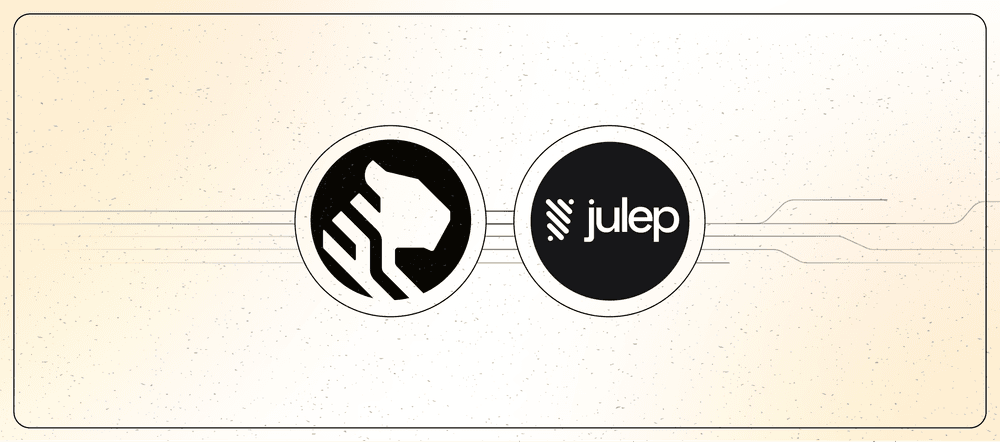Category: All posts
Aug 05, 2025

Posted by
Noah Hein
Julep AI is an open-source platform that lets developers compose and run sophisticated agentic AI workflows, providing a backend so agents can remember past interactions and orchestrate complex, multi-step tasks at scale. Founded by veteran AI builder Diwank Tomer, Julep targets teams that need multi-step reasoning, tool integrations, and rich context windows for their AI, all without wrestling with undifferentiated backend infrastructure. The platform manages long-term memory, branching logic, parallel tool calls, and real-time monitoring so developers can focus on their AI logic instead of reinventing plumbing.
However, building a production-grade AI system posed serious data challenges. As usage grew, Julep needed a data layer that could:
In short, Julep’s data architecture had to unify time-series event tracking and vector search, with high performance and minimal ops overhead. The typical approach for AI apps is to juggle multiple systems (analytics DB, vector DB, cache, etc.), but that introduces synchronization headaches and stale data. Diwank’s team was determined to avoid this complexity. As he puts it, “All roads lead back to Postgres,” so they set out to push Julep’s state, memory, and observability entirely into TigerData’s PostgreSQL platform.
“Other vector databases and logging platforms were either too rigid, too expensive, or didn’t allow us to keep things Postgres-native.” — Diwank Tomer, Founder of Julep
Building Julep’s agent platform revealed several key requirements, each with its own challenges:
Julep found its answer by building on TigerData’s PostgreSQL platform (TimescaleDB + pgVector/pgAI). Instead of spinning up new systems, they extended Postgres with time-series and vector capabilities to meet all the needs. Key building blocks of the solution include:
ai.create_vectorizer(...) triggers the database to generate an embedding and store it alongside the source data. This replaced what used to be a complex offline pipeline. “Before pgAI, we had a whole Temporal workflow – 300–400 lines of code – just to generate and cache embeddings,” Diwank recalls. “Now it’s one SQL function.” By treating embeddings as derived data (like an index), the database keeps them in sync with the source text automatically, eliminating consistency bugs.Why go all-in on TigerData for these features? The decision was driven by familiarity and proven performance. The team had prior experience with TimescaleDB (created by the TigerData team), and they trusted Postgres’ reliability. Using extensions (rather than new external datastores) meant zero application refactoring; Julep’s code could continue treating the database as “the source of truth” for both logical state and vector memory. As Diwank puts it, “TimescaleDB is a toolkit that lets you do things in Postgres that weren’t previously possible for our use case.” By pushing more logic into the database, Julep minimized the moving parts in production. The end result is a lean, powerful data stack: one Postgres cluster (on Tiger Cloud) that handles event streaming, real-time analytics, and AI semantic search all together.
Adopting TigerData’s Postgres-native solution has paid off tremendously for Julep. They transformed a tangle of data concerns into a single, elegant stack – and their users and engineers are feeling the benefits:
By embracing TigerData’s Postgres-native approach, Julep has turned its data layer from a potential bottleneck into a competitive advantage. The platform delivers real-time, memory-augmented AI agents without a maze of ancillary systems. Julep’s experience shows that for AI applications, unifying your state and vector data in one database can dramatically accelerate development while simplifying operations.
Looking ahead, TimescaleDB and pgAI are set to remain core to Julep’s roadmap. The team has several exciting explorations on the horizon:
First, the Open Responses API is slated to add real-time streaming so partial results, progress updates, and connection-keep-alive messages can reach front-end users the instant an agent starts thinking. Companion work includes a secure deletion endpoint (with cascading options and audit logs) and richer tool-call integrations that translate agent requests into external actions without extra glue code. On the performance side, the roadmap lists automatic smart truncation, context-length optimization, and other scaling tweaks to keep inference latency low as datasets grow.
In sum, Julep’s partnership with TigerData has empowered them to build the next generation of AI agents with speed, simplicity, and confidence. By trusting Postgres to do the heavy lifting, Julep can concentrate on innovating in the agent space. As more companies discover the benefits of this unified approach, Julep stands as a compelling case study: sometimes, the fastest way to build cutting-edge AI is to lean on the fastest PostgreSQL under the hood.